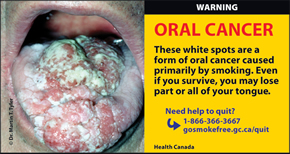Health Warnings
How acceptable is it for alleged civilized societies to force a legal industry to plaster cigarette packages with medical pornography that countries such as Canada and Australia have adopted? How would the public feel if aborted fetuses were plastered on condom dispensers, dismembered bodies were painted on every vehicle or smashed skulls appeared on every ski slope?
But even if one believes that the ends justify these barbaric means, how effective are these warnings in scaring people into not starting smoking or stopping? Let's hear what the experts have to say:
Excerpt from: Saying is not (always) doing: cigarette warning labels are useless
- "In summary, high personal relevance (smoking), in combination with low self-efficacy for the recommended action (quitting), leads to defensive reactions as a result of fear-arousing messages. This ‘psychological immune system’ helps in maintaining a positive self-image and may operate largely outside of awareness. Defensive reactions serve to get rid of the fear, not necessarily the threat. Policy makers should thus be reluctant to introduce cigarette warning labels and should instead focus on more effective interventions and policies.:"
In fact, according to this study The effect of pictorial warnings on cigarette packages on attentional bias of smokers, those who are more at risk for smoking related diseases -- the heavy smokers -- in an effort to alleviate the anxiety these warnings cause them, crave cigarettes even more.
- " Psychometric measures on anxiety and nicotine craving were administered. Light smokers showed an attentional bias towards packages without pictorial warnings while no effects were observed in the other groups. In heavy smokers attention allocation towards pictorial health warnings was associated with an increase of craving and anxiety. The results have a potential public health perspective as pictorial health warnings might be an effective strategy to reduce attentional bias towards cigarette packages of light smokers, while counterproductive effects in heavy smokers warrant further investigation. :"
Medical pornography Canadian style

